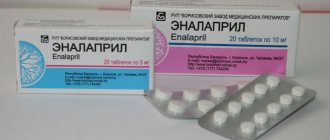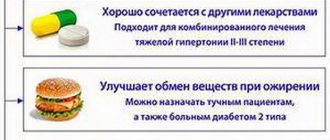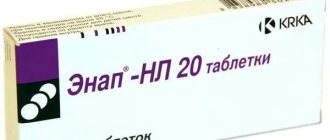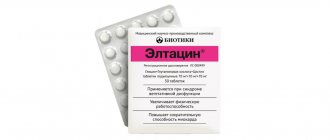Dicynon for uterine bleeding In case of uterine bleeding, synthetic drugs are often prescribed that have a beneficial effect on the lining of the uterine cavity. Such a drug is dicinone. Its pharmacological properties include the following: the ability to activate the process of formation of the thromboplastin protein; normalizing blood clotting prevents the formation of blood clots. Dicynone is available in several forms: tablets, injections. This drug has proven its effectiveness in treating bleeding that is localized in small vessels. After taking dicinone (the dosage should be prescribed only by the attending physician), a woman will be able to feel the effect within a few hours. Repeated testing of this drug has shown that the highest results are achieved when taking tablets rather than intramuscular injections. To stop uterine bleeding, experts use the following regimen: two ampoules of dicinone are administered intravenously (can be intramuscularly), after which this drug is prescribed in tablet form every six hours. In order to prevent bleeding, the patient should take this drug orally, starting from the 5th day of the menstrual cycle.
Tranexam for uterine bleeding Tranexam is rightfully considered the first aid for uterine bleeding, since it can very quickly cope with this problem. This drug has a direct effect on the blood clotting process and directly affects plasminogen (inactive). Tranexam is now available in pharmacies, both in the form of tablets and in the form of injections (intramuscular). If moderate blood loss is observed, then tablets will be sufficient. When determining the dosage, the doctor must take into account the patient’s weight and the severity of the disease. Tranexam is often prescribed to prevent uterine bleeding, especially when preparing patients for surgical procedures.
Vikasol for uterine bleeding Vikasol is a synthetic medical drug that can replace vitamin K, which is important for women’s health, and is actively involved in the production of prothrombin. In the absence or insufficient amount of this vitamin, women develop bleeding. After taking Vikasol, patients experience relief only after 12-18 hours, which is why it is not used in emergency care. Despite this, many doctors often prescribe this drug in the complex treatment of uterine bleeding, as well as for preventive purposes. Vikasol is prescribed to pregnant women after the onset of the first contractions to prevent the development of bleeding, which may develop during the onset of the active phase of labor.
Etamsylate for uterine bleeding For menstrual bleeding, doctors often prescribe medications that can significantly reduce the volume of menstruation. A great effect is achieved when taking etamsylate, which has extensive pharmacological properties: it has the ability to stop bleeding; activates the processes responsible for blood clotting and the rate of platelet adhesion; increases the elasticity and stability of capillaries, etc. While taking etamsylate, patients do not experience internal discomfort, since this drug has a smooth effect on the female body. In the process of conducting numerous studies, it was revealed that ethamsylate does not cause sudden blood clotting, which prevents the formation of blood clots. It is prescribed for any type of bleeding, in particular uterine. Very often, etamsylate is included in the treatment program for heavy menstrual flow, as well as otolaryngological, dental and ophthalmological diseases. Oxytocin for uterine bleeding Oxytocin When uterine bleeding develops, the first action of a specialist is to prescribe a drug to the woman that can quickly provide the necessary assistance. Oxytocin, which has a selective effect on the uterus, can stop blood loss. After taking oxytocin, the female body experiences increased excitability of muscle fibers, against the background of which strong contractions begin. This drug can be prescribed both in tablet form and as intravenous injections. Ascorutin for uterine bleeding Ascorutin, which has been actively used in gynecology for many years, can provide real help to women suffering from heavy periods, often developing into uterine bleeding. This medicine contains the following main components: vitamin P (rutin) and ascorbic acid. Its direct effect on the female body is to strengthen the walls of blood vessels, preventing fragility and permeability of capillaries. With long-term use of ascorutin (the duration is determined by the attending physician), tissue regeneration occurs, and the protective functions of the female body are activated, capable of resisting any negative effects. Vikasol for uterine bleeding An effective synthetic drug that can replace and saturate the female body with vitamin K is Vikasol. This drug activates the process of prothrombin production, which has a direct effect on blood clotting. Despite the fact that Vikasol has proven its effectiveness in the treatment of uterine bleeding, its use should be very careful. Like any other hemostatic drug, Vicasol has contraindications, which include: thromboembolism and increased blood clotting. That is why self-administration of this drug is prohibited. All prescriptions must be given only by the attending physician. Etamzilat (injections) for uterine bleeding Etamzilat is a medical drug with hemostatic properties. While taking this drug, patients experience strengthening of blood vessels, an increase in platelet cells in the bone marrow, etc. After prescribing ethamsylate in women, the fragility of blood vessels is significantly reduced, and the level of ascorbic acid in the blood plasma is stabilized. When taking this drug, the effect is observed after 10-15 minutes. Having had a beneficial effect on the patient’s body, etamsylate begins to break down very quickly and is excreted during urination.
Aminocaproic acid for uterine bleeding Aminocaproic acid is a synthetic medical drug often used to stop uterine bleeding. Its prescription should only occur in a hospital, where doctors have the opportunity to regularly monitor the quality of patients’ blood through a laboratory test - a coagulogram. Aminocaproic acid can improve liver functionality and also inhibit the process of antibody formation.
Tranexam tablets 250 mg 10 pcs ➤ instructions for use
Inside, regardless of food intake.
Short-term treatment of bleeding caused by increased fibrinolysis:
The recommended standard dose of tranexamic acid is 15-25 mg/kg body weight, on average 1000-1500 mg 2-3 times a day.
- For prostatectomy and surgical interventions on the bladder:
1000 mg 6 hours before surgery, then 1000 mg 3-4 times a day until gross hematuria disappears. It is not recommended to use the drug for more than 2 weeks after surgery. - For menorrhagia:
the recommended dose is 1000 mg 3 times a day until menorrhagia stops, but not more than 4 days. In case of profuse bleeding, the dose of the drug can be increased, but the total daily dose should not exceed 4000 mg. Treatment with tranexamic acid should not be started before menstrual bleeding occurs. In clinical studies, tranexamic acid was not used for more than three consecutive menstrual cycles. - For recurrent nosebleeds:
1000 mg 3 times a day for 7 days. - After cervical conization surgery:
1500 mg 3 times a day for 12 days after surgery. - For traumatic hyphema:
1000-1500 mg 3 times a day (target dose 25 mg/kg body weight) for 7 days. - Patients with hemophilia:
the drug is prescribed orally at a dose of 25 mg/kg body weight 2 hours before tooth extraction, and then 1000-1500 mg 3 times a day for 6-8 days. Coagulation factors VIII or IX should be prescribed simultaneously. - For hereditary angioedema:
1000-1500 mg 2-3 times a day. If the patient can foresee an exacerbation of the disease, the drug can be taken intermittently depending on the presence of prodromal symptoms. In other cases, the drug should be taken continuously. - Bleeding during pregnancy:
250-500 mg 3-4 times a day until bleeding stops completely. The average duration of treatment is 7 days.
Use of the drug in special groups of patients
Renal dysfunction
In patients with mild to moderate impairment of renal excretory function, adjustment of the dose and frequency of tranexamic acid administration is necessary:
| Serum creatinine concentration | Glomerular filtration rate (GFR) | Tranexamic acid dose | Frequency of reception |
| 120-249 µmol/l (1.36-2.82 mg/dl) | 60-89 ml/min/1.73m2 | 15 mg/kg body weight | 2 times a day |
| 250-500 µmol/l (2.83-5.66 mg/dl) | 30-59 ml/min/1.73m2 | 15 mg/kg body weight | 1 time per day |
Liver dysfunction
In patients with impaired liver function, no dose adjustment is required.
Elderly age
In elderly patients in the absence of renal failure, no dose adjustment is required.
Childhood
Data regarding the effectiveness and safety of tranexamic acid in children are limited.
In children, tranexamic acid is prescribed at a rate of 25 mg/kg body weight 2-3 times a day.
What to do if you miss a dose
If you miss one dose, you must take the next dose of the drug at the prescribed time. You should not take a double dose of the drug after missing the next dose.
Tranexam 250 mg 10 pcs. film-coated tablets
pharmachologic effect
Antifibrinolytic agent.
Tranexamic acid specifically inhibits the activation of profibrinolysin (plasminogen) and its conversion to fibrinolysin (plasmin). It has a local and systemic hemostatic effect for bleeding associated with increased fibrinolysis (platelet pathology, menorrhagia). Also, tranexamic acid, by suppressing the formation of kinins and other active peptides involved in allergic and inflammatory reactions, has anti-allergic and anti-inflammatory effects. Absorption after oral administration of doses in the range of 0.5-2 g is 30-50%. The time to reach the maximum concentration when taken orally is 0.5, 1 and 2 g-3 hours, the maximum concentration is 5, 8 and 15 mcg/ml, respectively. Communication with plasma proteins (profibrinolysin) - less than 3%.
Distributed relatively evenly in tissues (with the exception of cerebrospinal fluid, where the concentration is 1/10 of the plasma concentration); penetrates the placental barrier into breast milk (about 1% of the concentration in maternal plasma). It is found in seminal fluid, where it reduces fibrinolytic activity, but does not affect sperm migration. The initial volume of distribution is 9-12 liters. Antifibrinolytic concentration in various tissues lasts 17 hours, in plasma - up to 7-8 hours.
A small part is metabolized. The concentration-time curve has a three-phase shape with a half-life in the final phase of 3 hours. Total renal clearance is equal to plasma (7 l/h). Excreted by the kidneys (the main route is glomerular filtration) - more than 95% unchanged during the first 12 hours.
Two metabolites of tranexamic acid have been identified: N-acetylated and deaminated derivatives. In case of impaired renal function, there is a risk of accumulation of tranexamic acid.
Composition and release form Tranexam 250 mg 10 pcs. film-coated tablets
One tablet contains: tranexamic acid 250 mg.
Excipients (core): microcrystalline cellulose, hyprolose, sodium carboxymethyl starch, talc, colloidal silicon dioxide, calcium stearate.
Excipients (shell): hypromellose, titanium dioxide, talc, macrogol. Film-coated tablets, 250 mg. 10 tablets in a blister pack made of polyvinyl chloride film and printed varnished aluminum foil. 1, 2, 3, 5 blister packs along with instructions for use are placed in a cardboard pack.
Description of the dosage form
Film-coated tablets
Characteristic
The tablets are biconvex, white, film-coated. On a cross section - white or white with a creamy or grayish tint.
Directions for use and doses
Inside, regardless of food intake.
Short-term treatment of bleeding caused by increased fibrinolysis:
The recommended standard dose of tranexamic acid is 15-25 mg/kg body weight, on average 1000-1500 mg 2-3 times a day.
- For prostatectomy and surgical interventions on the bladder: 1000 mg 6 hours before surgery, then 1000 mg 3-4 times a day until gross hematuria disappears. It is not recommended to use the drug for more than 2 weeks after surgery.
- For menorrhagia: the recommended dose is 1000 mg 3 times a day until menorrhagia stops, but not more than 4 days. In case of profuse bleeding, the dose of the drug can be increased, but the total daily dose should not exceed 4000 mg. Treatment with tranexamic acid should not be started before menstrual bleeding occurs. In clinical studies, tranexamic acid was not used for more than three consecutive menstrual cycles.
- For recurrent nosebleeds: 1000 mg 3 times a day for 7 days.
- After cervical conization surgery: 1500 mg 3 times a day for 12 days after surgery.
- For traumatic hyphema: 1000-1500 mg 3 times a day (target dose 25 mg/kg body weight) for 7 days.
Patients with hemophilia: the drug is prescribed orally at a dose of 25 mg/kg body weight 2 hours before tooth extraction, and then 1000-1500 mg 3 times a day for 6-8 days. Coagulation factors VIII or IX should be prescribed simultaneously.
For hereditary angioedema: 1000-1500 mg 2-3 times a day. If the patient can foresee an exacerbation of the disease, the drug can be taken intermittently depending on the presence of prodromal symptoms. In other cases, the drug should be taken continuously.
Bleeding during pregnancy: 250-500 mg 3-4 times a day until bleeding stops completely. The average duration of treatment is 7 days.
Use of the drug in special groups of patients
Renal dysfunction
In patients with mild to moderate impairment of renal excretory function, adjustment of the dose and frequency of tranexamic acid administration is necessary:
Serum creatinine concentration | Glomerular filtration rate (GFR) | Tranexamic Acid Dose | Frequency of reception
120-249 µmol/l (1.36-2.82 mg/dl) | 60-89 ml/min/1.73m2 | 15 mg/kg body weight | 2 times a day
250-500 µmol/L (2.83-5.66 mg/dL) | 30-59 ml/min/1.73m2 | 15 mg/kg body weight | 1 time per day
Liver dysfunction
In patients with impaired liver function, no dose adjustment is required.
Elderly age
In elderly patients in the absence of renal failure, no dose adjustment is required.
Childhood
Data regarding the effectiveness and safety of tranexamic acid in children are limited.
In children, tranexamic acid is prescribed at a rate of 25 mg/kg body weight 2-3 times a day.
What to do if you miss a dose
If you miss one dose, you must take the next dose of the drug at the prescribed time. You should not take a double dose of the drug after missing the next dose.
Pharmacodynamics
Antifibrinolytic agent. Tranexamic acid specifically inhibits the activation of profibrinolysin (plasminogen) and its conversion to fibrinolysin (plasmin). It has a local and systemic hemostatic effect for bleeding associated with increased fibrinolysis (platelet pathology, menorrhagia). Also, tranexamic acid, by suppressing the formation of kinins and other active peptides involved in allergic and inflammatory reactions, has anti-allergic and anti-inflammatory effects.
Pharmacokinetics
Absorption after oral administration of doses in the range of 0.5-2 g is 30-50%. The time to reach the maximum concentration when taken orally 0.5, 1 and 2 g is 3 hours, the maximum concentration is 5, 8 and 15 mcg/ml, respectively. Communication with plasma proteins (profibrinolysin) - less than 3%.
Distributed relatively evenly in tissues (with the exception of cerebrospinal fluid, where the concentration is 1/10 of the plasma concentration); penetrates the placental barrier into breast milk (about 1% of the concentration in maternal plasma). It is found in seminal fluid, where it reduces fibrinolytic activity, but does not affect sperm migration. The initial volume of distribution is 9-12 liters. Antifibrinolytic concentration in various tissues lasts 17 hours, in plasma - up to 7-8 hours.
A small part is metabolized. The concentration-time curve has a three-phase shape with a half-life in the final phase of 3 hours. Total renal clearance is equal to plasma (7 l/h). Excreted by the kidneys (the main route is glomerular filtration) - more than 95% unchanged during the first 12 hours.
Two metabolites of tranexamic acid have been identified: N-acetylated and deaminated derivatives. In case of impaired renal function, there is a risk of accumulation of tranexamic acid.
Indications for use Tranexam 250 mg 10 pcs. film-coated tablets
Short-term treatment of bleeding associated with increased fibrinolysis in the following pathological conditions:
- Prostatectomy; surgical interventions on the bladder;
- Menorrhagia;
- Nose bleed;
- Conization of the cervix;
- Traumatic hyphema (hemorrhage into the anterior chamber of the eye).
Prevention and treatment of bleeding in patients with hemophilia who undergo minor surgery (including tooth extraction);
Hereditary angioedema (prevention of exacerbations of the disease).
Bleeding during pregnancy.
Contraindications
- Hypersensitivity to tranexamic acid or other components of the drug;
- Severe chronic renal failure (glomerular filtration rate [GFR] less than 30 mg/ml/1.73 m2) due to the risk of accumulation;
- Venous or arterial thrombosis currently or in history (deep vein thrombosis of the legs, pulmonary embolism, thrombosis of intracranial vessels, etc.) if simultaneous anticoagulant therapy is impossible;
- Fibrinolysis due to consumption coagulopathy (hypocoagulable stage of disseminated intravascular coagulation syndrome [DIC]);
- history of seizures;
- Acquired color vision impairment;
- Subarachnoid hemorrhage (due to the risk of developing cerebral edema, ischemia and cerebral infarction);
- Children up to 3 years of age (solid dosage form).
Application of Tranexam 250 mg 10 pcs. film-coated tablets during pregnancy and breastfeeding
In preclinical studies, tranexamic acid did not have a teratogenic effect. Adequate and strictly controlled studies of the effectiveness and safety of tranexamic acid in pregnant women have not been conducted. Tranexamic acid crosses the placenta and may be present in cord blood in concentrations close to maternal levels.
Because animal reproduction studies do not always predict reactions in humans, tranexamic acid should be used during pregnancy only when absolutely necessary.
Tranexamic acid passes into breast milk (the concentration of the drug in milk is about 1% of the concentration in the mother's blood plasma). The development of an antifibrinolytic effect in an infant is unlikely. However, caution should be exercised when using tranexamic acid in nursing mothers.
special instructions
Tranexamic acid should be used with caution in the following situations:
- Hematuria caused by diseases of the renal parenchyma and bleeding from the upper urinary tract (risk of secondary mechanical obstruction of the urinary tract by a blood clot with the development of anuria) (See section "Special instructions");
- Patients with a high risk of developing thrombosis (history of thromboembolic events or family history of thromboembolic diseases, verified diagnosis of thrombophilia);
- Disseminated intravascular coagulation syndrome [DIC syndrome]);
- Presence of blood in cavities, for example, in the pleural cavity, joint cavities and urinary tract;
- Patients receiving anticoagulant therapy (experience is limited);
- Simultaneous use of drugs of blood coagulation factors II, VII, IX and X in combination with [prothrombin complex] or anti-inhibitor coagulant complex (See section “Interaction with other drugs”);
- Treatment of menorrhagia in patients under the age of 15 years (experience is limited);
- Patients taking combined oral contraceptives (due to an increased risk of venous thromboembolic complications and arterial thrombosis) (See section "Interaction with other drugs").
Overdose
There are limited data on cases of overdose. One case of overdose has been reported (ingestion of 37 g of tranexamic acid).
Symptoms: dizziness, headache, nausea, vomiting, diarrhea, orthostatic symptoms (including dizziness when moving from a horizontal to a vertical position), orthostatic arterial hypotension. Predisposed patients have an increased risk of thrombosis.
Treatment: no known antidote. If an overdose of tranexamic acid is suspected, hospitalization is necessary. When providing assistance, induce vomiting, then perform gastric lavage. Activated carbon reduces the absorption of tranexamic acid when taken orally during the first 1-2 hours after an overdose. If the patient is unconscious or has difficulty swallowing, activated charcoal can be administered through a nasogastric tube. It is recommended to take orally or parenterally administer large amounts of fluid to enhance renal excretion, forced diuresis, and control the amount of urine excreted. In some cases, the use of anticoagulants may be justified.
Side effects Tranexam 250 mg 10 pcs. film-coated tablets
The incidence of adverse drug reactions is determined in accordance with the WHO classification: very often (more than 1/10), often (more than 1/100, ≤1/10), infrequently (more than 1/1000, ≤1/100), rarely (more than 1/10000, ≤1/1000), very rare (less than 1/10000), frequency unknown (cannot be determined from available data).
Gastrointestinal disorders: often - nausea, vomiting, diarrhea (symptoms disappear when the dose is reduced).
Disorders of the skin and subcutaneous tissues: rarely - allergic skin reactions, including allergic dermatitis.
Disorders of the organ of vision: rarely - visual disturbances, including impaired color perception, thrombosis of retinal vessels.
Vascular disorders: rarely - thromboembolic complications, marked decrease in blood pressure (usually due to excessively rapid intravenous administration, in exceptional cases - after oral administration); very rarely - arterial and venous thrombosis of various locations; frequency unknown - acute myocardial infarction, cerebral artery thrombosis, carotid artery thrombosis, stroke, deep vein thrombosis of the legs, pulmonary embolism, renal artery thrombosis with the development of cortical necrosis and acute renal failure, occlusion of coronary artery bypass graft, thrombosis of the central artery and retinal vein .
Immune system disorders: very rarely - hypersensitivity reactions, including anaphylactic shock.
Nervous system disorders: rarely - dizziness, convulsions (usually with intravenous administration).
Drug interactions
Special clinical studies have not been conducted to study the interactions of tranexamic acid with other drugs.
Tranexamic acid prevents the development of the pharmacological effect of fibrinolytic (thrombolytic) drugs.
Combined oral contraceptives increase the risk of venous thromboembolic complications and arterial thrombosis (in particular, ischemic stroke and myocardial infarction). There is no experience with the use of tranexamic acid in women taking combined oral contraceptives. Since tranexamic acid has an antifibrinolytic effect, simultaneous use with combined oral contraceptives may lead to an additional increase in the risk of thrombotic complications.
The simultaneous use of tranexamic acid with drugs of blood coagulation factors II, VII, IX and X in combination [prothrombin complex] or anti-inhibitor coagulant complex increases the risk of thrombosis.
There may be an increased risk of thrombotic complications (in particular myocardial infarction) with simultaneous use of tranexamic acid with hydrochlorothiazide, desmopressin, ampicillin-sulbactam, ranitidine and nitroglycerin.
When combined with hemostatic drugs, activation of thrombus formation is possible.
Concomitant use of tranexamic acid with anticoagulants should be carried out under the strict supervision of a physician (experience is limited).





